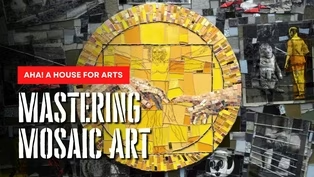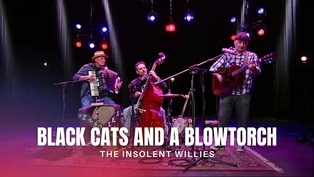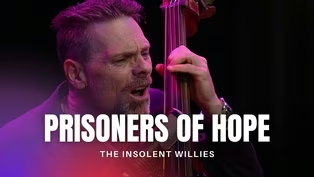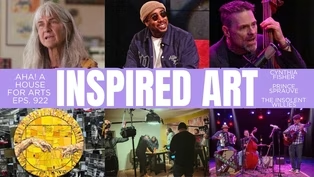
How a High School Program Sparked a Filmmaking Revolution
Clip: Season 9 Episode 22 | 9m 54sVideo has Closed Captions
Prince Sprauve's journey from Schenectady High to acclaimed filmmaker.
Prince shares how his afterschool program led to the creation of his first film, "Fast Life," and his commitment to addressing social issues through his work. Learn about his new initiatives, community impact, and his vision for the future of filmmaking in the region.
Problems playing video? | Closed Captioning Feedback
Problems playing video? | Closed Captioning Feedback
AHA! A House for Arts is a local public television program presented by WMHT
Support provided by the New York State Council on the Arts (NYSCA), M&T Bank, the Leo Cox Beach Philanthropic Foundation, and is also provided by contributors to the WMHT Venture...

How a High School Program Sparked a Filmmaking Revolution
Clip: Season 9 Episode 22 | 9m 54sVideo has Closed Captions
Prince shares how his afterschool program led to the creation of his first film, "Fast Life," and his commitment to addressing social issues through his work. Learn about his new initiatives, community impact, and his vision for the future of filmmaking in the region.
Problems playing video? | Closed Captioning Feedback
How to Watch AHA! A House for Arts
AHA! A House for Arts is available to stream on pbs.org and the free PBS App, available on iPhone, Apple TV, Android TV, Android smartphones, Amazon Fire TV, Amazon Fire Tablet, Roku, Samsung Smart TV, and Vizio.
Providing Support for PBS.org
Learn Moreabout PBS online sponsorship- I mean, first of all, I just wanna give a shout-out to the whole region, the 518.
I'm originally from Brooklyn but 518 took me in, specifically Schenectady.
And I remember I was 21 years old when I started working at Schenectady High School, and I was there and I started an afterschool program where kids could do audio and video, and basically the young people, they made me a director.
The people made me a director.
I didn't make myself a director, I wasn't even thinking about video.
If anything, I didn't really want to do it, I really wanted to do the music 'cause I was an artist first.
I really wanted to do audio engineering, and through Schenectady City School District's opportunities, where I was able to be an assistant station manager, that's where I picked up a camera and I shot my first film back in 2010.
I remember I had over 70 students in my afterschool program and we were shooting this music video, and I told them, I said, "Listen, let's make like a cinematic music video.
Let's get something going like 'Thriller'."
And they kept adding scenes and I said, "If you keep adding scenes, it's not gonna be a cinematic music video it's gonna turn into a short film."
And I remember I had over 80 young people like, "Yo, Sprauve, forget the music video let's make a movie.
Forget all that."
I said, "I can't make no movie."
They said, "Sprauve, if anybody could figure it out, you could figure it out."
Three years later I dropped "Fast Life" in Proctors.
Over 2,000 people showed up, you're talking about over 150 students involved in that project.
I took $1,000 and raised 50 grand, and from that I launched "Cradle", "Make It Home" and then "The Last Shot".
- I know a lot of your film deals with social issues, a lot of rawness.
- Yes.
- Some dark, some not.
- Yes.
- What is your approach to getting this, there has to be community input- - Yes, absolutely.
- 'Cause you're going in and you're filming the community on these sensitive topics.
- Yes.
- So, how do you handle that as a director, an artist, and a human being?
- Number one, you gotta remember that the people are more important than the story.
For the story to be relevant, the people gotta be relevant.
And when I go into an approach and I'm talking about sensitive topics, there's a trust factor there between me and the people.
They understand that I'm not doing this for clout, this is not for popularity, this is not- who would wanna do all this work for not enough pay?
So the only reason why you would do it is because of your why.
You understand that I have an understanding that our population is- we don't get these opportunities, we don't get to tell our story.
When stuff happens it's like, "Just move on."
In my last project, "The Last Shot", it was a gun prevention project.
The county approached me about doing- they had got some grant prevention funds, and I said, "Listen, let's shoot a film, let's do something real.
But if we're going to do this, let's go all the way.
It's not gonna look like how you want it to look, it's not gonna sound like how you want it to sound because art is a reflection of us.
That's what true art is, so don't get mad at the messenger for giving you a raw message that goes on every single day."
We did a story about a young man by the name of Eddie Stanley Jr., a 15-year-old Schenectady High School student who snuck out to a party and was shot five times over a pair of keys.
- Wow.
- It's just unrealistic to even think that that can happen.
I know I've snuck out of the house plenty of times, but I've never been in a situation where I went to a party thinking that I'm gonna get shot five times.
Even though I know there's danger in the room, you don't go into that situation like that.
And instead of using actors, we used the real people that were there that night.
I pulled the real 911 calls, we pulled the case.
The father is in the film.
Eddie Stanley Sr. actually owns part of the film with me, so, the copyrights, he has ownership of his son's story.
And that's what I mean by trust factor, it's just like, it's not about me it's about us.
- And do any of your students work in there 'cause I know you still work with students in the- - Absolutely, we had 10 students...
Specifically for this project, "The Last Shot", we had 10 students from the Boys and Girls Club.
And I paid them the entire process.
They actually did all the research with me, they came up with the name, they did the storyline with me, they listened to confidential interviews.
I spoke to all their parents about the details of what this was gonna be and how we were framing it from an educational standpoint of view, and how not only are they learning about the dangers of guns, but they're getting trained in film jobs and film industry jobs.
And they loved it, they was there every step of the way, from the time that we stepped on set they were there as PAs, carrying stuff, moving stuff around, staying true to the story.
And then some of them was even in the film, they was in the film, they were like, "Sprauve, we want to be in front of the camera too."
- Actors, yeah.
- Whatever you wanna do, the sky's the limit.
And I paid them, and I think that our young people, to do this, this is an essential job.
Film is essential.
And to think that it's not is crazy, it's a billion-dollar industry.
So I've always worked with young people on every one of my projects.
- Wow.
And you have a new grant too, right?
- Yes.
- Aren't you doing a new initiative right now?
- Absolutely.
So I partner with the SEAT Program, SEAT Center, which is Social Enterprise and Training.
And what they do is that they train 18- to 24-year-olds for the workforce.
Construction, HVAC, culinary, and film is their new program that we're launching there.
So we received a grant that would allow us to launch a film and music program, build a recording studio, get state-of-the-art equipment and train 18 and up- - Wow.
- Not just 18 to 24.
- So that's a big thing, that's a big change.
- It's huge.
- New York State came back to us and said, "Listen, we know that you serve 18 to 24, but we would prefer the program to be 18 and up."
So now somebody that's 30, 31 can go through this program, 15 weeks, get trained as a boom operator, do sound, scout location, become a cinematographer, be a freelance videographer.
If you wanna be a film and video editor, you can be all of that.
And there's opportunities there because not only are we training them for 15 weeks, but then I hire them on my sets.
The idea is not to just give them a trade that we're gonna you empty-handed because we know that the region traditionally has struggled with the film economy.
So it's up to us to create those jobs, and that's why my next movie is actually tied into all of my graduates.
So my next feature that I'm shooting next year, which is about YouthBuild, is actually, the movie is about YouthBuild.
I'm gonna feature and have all of my graduates as PAs, and I'm gonna pair them with industry professionals so that we don't lack quality and we don't lack training.
Everybody's winning and that money that we spend, it would be right here in the region.
- And that's amazing because you really are revitalizing the film industry here.
- Yes.
- You're really building upon this creative economy.
- Absolutely.
- Is that a goal of yours, is that something you're trying to grow the region- - Absolutely, because even though the region has been behind, we are ripe, we are right there.
I think that we need a big enough project that everybody can get behind so that we can get national distribution.
One of my films, I will say right now, "The Last Shot" specifically, just was picked up by a network.
I won't say the name right now but that's a big deal, because that's national distribution.
And with us being able to do projects, the talent is here in the 518, the talent is just limitless in what we can do but the problem is that we don't have production.
We don't know how to grow this project for the entire region.
We're limited to social media, we're limited to our friends, we're limited to our circles, and when you have a whole bunch of creatives acting in silos and no one is really doing hard collaborations between cities, it makes it hard to grow the economy; but that's a goal of mine, is to stimulate the economy 'cause before you can stimulate it you gotta grow the culture.
- Absolutely.
- And with culture comes education.
So that's why the film and music program is so important, because now we have a hub where people can go and say, "If I wanna get into acting, this is a place that I can go to get into acting.
If I wanna get into film and learn about how a film set works, SEAT Center, Prince Sprauve, Quiet on Set are places that I can go and learn these things, and get a real case of what is the film industry really like, not just within your parameters.
- Yeah, just at Hollywood, yeah- - Right, right.
Going to film festivals, networking with people that don't do the same genre as you, learning from their models of how they did film, bringing those ideas and concepts back to the region and just not reinventing the wheel but growing on that.
- No, exactly.
I'm so excited to see everything you do and appreciative- - Absolutely, I appreciate it.
- ... of all the educational resources, all these initiatives, 'cause I've been saying, "If anyone knows me, I've been saying this forever.
We have so many creatives, we're so ripe and we're just ready to go but there's no infrastructure for us to succeed yet.
So it's just really amazing to see people like you out here just doing the work and really building up the city to be the best it can be, man.
- Absolutely, because I just really feel like film is a billion-dollar industry.
Any city that film has touched film has transformed.
We don't know LA because LA was LA, we know LA because of movies.
- "Bad Boys".
- So just thinking about that, what it brings to the city, how many businesses are fed, how many people are inspired to wanna get up and we're do something and we're create, and we're follow their passion.
That's what film is all about for me.
How Cynthia Fisher Mastered Mosaic Art
Video has Closed Captions
Clip: S9 Ep22 | 7m 22s | Discover Cynthia Fisher's journey from children's book illustrator to master mosaic artist. (7m 22s)
The Insolent Willies Perform "Black Cats And A Blowtorch"
Video has Closed Captions
Clip: S9 Ep22 | 3m 5s | Join The Insolent Willies in a riveting performance of"Black Cats And A Blowtorch". (3m 5s)
The Insolent Willies Perform "Prisoner Of Hope"
Video has Closed Captions
Clip: S9 Ep22 | 2m 45s | Join The Insolent Willies in a riveting performance of "Prisoner Of Hope". (2m 45s)
Inspired Art: Cynthia Fisher, Prince Sprauve, and The Insolent Willies - Preview
Video has Closed Captions
Clip: S9 Ep22 | 30s | Explore art, film, and music with Cynthia Fisher, Prince Sprauve, and The Insolent Willies on AHA! (30s)
Providing Support for PBS.org
Learn Moreabout PBS online sponsorshipSupport for PBS provided by:
AHA! A House for Arts is a local public television program presented by WMHT
Support provided by the New York State Council on the Arts (NYSCA), M&T Bank, the Leo Cox Beach Philanthropic Foundation, and is also provided by contributors to the WMHT Venture...



















